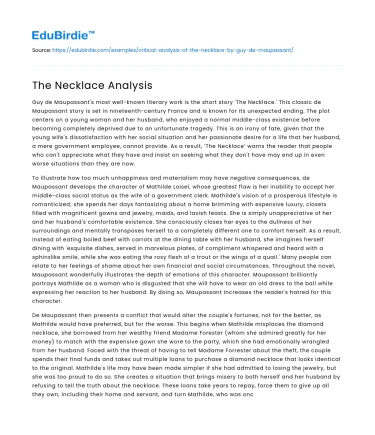Guy de Maupassant's most well-known literary work is the short story 'The Necklace.' This classic de Maupassant story is set in nineteenth-century France and is known for its unexpected ending. The plot centers on a young woman and her husband, who enjoyed a normal middle-class existence before becoming completely deprived due to an unfortunate tragedy. This is an irony of fate, given that the young wife's dissatisfaction with her social situation and her passionate desire for a life that her husband, a mere government employee, cannot provide. As a result, ‘The Necklace’ warns the reader that people who can't appreciate what they have and insist on seeking what they don't have may end up in even worse situations than they are now.
To illustrate how too much unhappiness and materialism may have negative consequences, de Maupassant develops the character of Mathilde Loisel, whose greatest flaw is her inability to accept her middle-class social status as the wife of a government clerk. Mathilde's vision of a prosperous lifestyle is romanticized; she spends her days fantasizing about a home brimming with expensive luxury, closets filled with magnificent gowns and jewelry, maids, and lavish feasts. She is simply unappreciative of her and her husband's comfortable existence. She consciously closes her eyes to the dullness of her surroundings and mentally transposes herself to a completely different one to comfort herself. As a result, instead of eating boiled beef with carrots at the dining table with her husband, she imagines herself dining with 'exquisite dishes, served in marvelous plates, of compliment whispered and heard with a sphinxlike smile, while she was eating the rosy flesh of a trout or the wings of a quail.' Many people can relate to her feelings of shame about her own financial and social circumstances. Throughout the novel, Maupassant wonderfully illustrates the depth of emotions of this character. Maupassant brilliantly portrays Mathilde as a woman who is disgusted that she will have to wear an old dress to the ball while expressing her reaction to her husband. By doing so, Maupassant increases the reader's hatred for this character.
Save your time!
We can take care of your essay
- Proper editing and formatting
- Free revision, title page, and bibliography
- Flexible prices and money-back guarantee
De Maupassant then presents a conflict that would alter the couple's fortunes, not for the better, as Mathilde would have preferred, but for the worse. This begins when Mathilde misplaces the diamond necklace, she borrowed from her wealthy friend Madame Forester (whom she admired greatly for her money) to match with the expensive gown she wore to the party, which she had emotionally wrangled from her husband. Faced with the threat of having to tell Madame Forrester about the theft, the couple spends their final funds and takes out multiple loans to purchase a diamond necklace that looks identical to the original. Mathilde's life may have been made simpler if she had admitted to losing the jewelry, but she was too proud to do so. She creates a situation that brings misery to both herself and her husband by refusing to tell the truth about the necklace. These loans take years to repay, force them to give up all they own, including their home and servant, and turn Mathilde, who was once beautiful and elegant, to a ‘robust woman, hard and rude, of a low household. Whose voice was loud, and she scrubbed the floor with splashing water, her hair badly combed, her skirts awry, and her hands red.’
As if emphasizing the point wasn't enough, de Maupassant concludes the story with a surprise twist that makes the reader sit up and take notice. Mathilde realizes that the diamond necklace provided to her by Madame Forester ten years after the incident, which triggered the tragic change in her life, was simply costume jewelry when they reunite ten years later. The fake diamond necklace appears to symbolize Mathilde and her husband's irrational sacrifices over the last ten years. Mathilde's anguish must have been compounded by the realization that her life had become absolutely impoverished as a result of a single piece of worthless jewelry. Mathilde should learn that vanity is useless and that individuals should be proud of who they are. Mathilde must also learn to be comfortable with what she has; ironically, she lost what she had because she was dissatisfied with it.
The moral of The Necklace Story is that we should not judge people based on their outward looks, as they may appear to be wealthy and successful but are not. It also teaches us not to yearn for material stuff, but to be content with what we have. ‘The Necklace’ is a story about unhappiness and irrational materialism. De Maupassant warns his readers that craving too much for material things that one can't have right now and ignoring the tiny things one already has won't bring positive outcomes. The risk that such a person would not only not receive the things he desires for himself, but may also lose the things he already has but does not value.






 Stuck on your essay?
Stuck on your essay?

